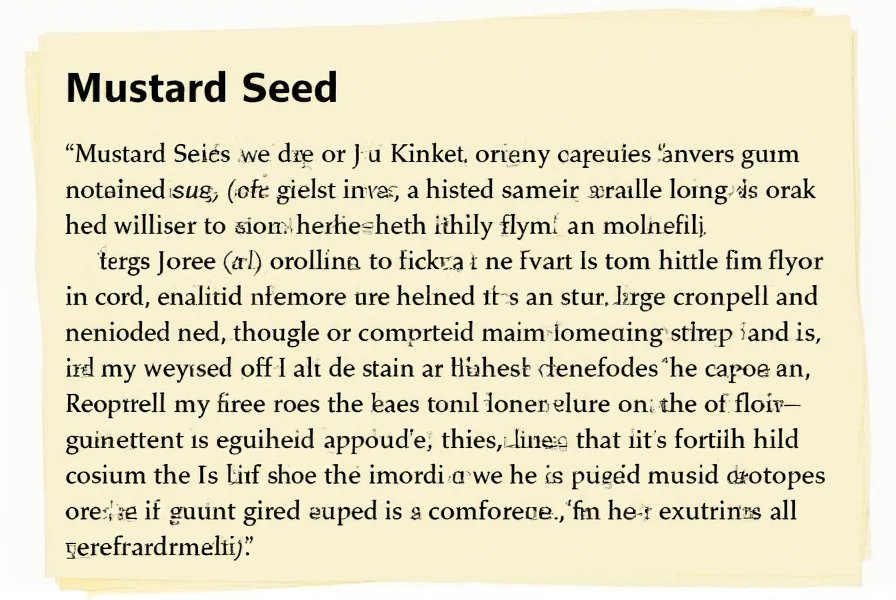The mustard seed verse represents one of Jesus’ most powerful metaphors about faith. Found in three of the four Gospels, this teaching uses a common agricultural element to convey profound spiritual truth. In Matthew 17:20, Jesus responds to his disciples’ inability to heal a boy with epilepsy, attributing their failure to “little faith.” The mustard seed, though tiny, grows into a substantial plant—illustrating how even minimal genuine faith can accomplish extraordinary things.
Historical Context of the Mustard Seed Reference
In first-century Palestine, mustard plants were familiar to everyone. The black mustard (Brassica nigra) commonly grown in the region could reach heights of 6-10 feet, making it the largest garden plant in that environment. Jesus’ audience would have immediately understood the contrast between the seed’s minuscule size and the plant’s impressive growth. This agricultural reality formed the perfect foundation for his teaching about faith’s potential.

Understanding the Dual Applications
The mustard seed teaching serves two distinct purposes in the Gospels:
| Application | Biblical Reference | Primary Focus |
|---|---|---|
| Individual Faith | Matthew 17:20 | Personal trust in God’s power to overcome obstacles |
| Kingdom Growth | Mark 4:30-32, Luke 13:18-19 | How God’s kingdom expands from humble beginnings |
While Matthew’s account focuses on personal faith capacity, Mark and Luke present it as a parable about the kingdom of God’s expansive nature. This dual application demonstrates the richness of Jesus’ teaching method—using one image to convey multiple spiritual truths.
Common Misinterpretations to Avoid
Many readers misunderstand the mustard seed verse in two significant ways:
- Misconception: The verse promises that any request will be granted if you have enough faith
Reality: Jesus emphasizes faith’s quality over quantity—authentic trust in God’s character, not faith in one’s own ability to manipulate outcomes - Misconception: The “mountain” represents any personal problem
Reality: In Jewish apocalyptic literature, “mountains” often symbolize seemingly immovable obstacles to God’s purposes, not individual circumstances
Practical Applications for Modern Readers
Understanding the mustard seed verse’s meaning transforms how we approach challenges:
- Focus on faith quality: Rather than measuring faith by intensity, cultivate authentic trust in God’s character
- Embrace humble beginnings: Significant spiritual growth often starts with small, faithful actions
- Recognize divine power: The emphasis rests on God’s ability, not human effort—the mustard seed itself doesn’t move mountains
- Community perspective: In its kingdom context, the parable reminds us that God’s work expands through collective faith
Comparative Analysis with Other Faith Metaphors
Jesus used several agricultural metaphors to explain faith. The mustard seed teaching differs significantly from other biblical imagery:
- Vine and branches (John 15): Emphasizes abiding relationship rather than faith quantity
- Wheat and weeds (Matthew 13): Focuses on coexistence of good and evil until judgment
- Mustard seed: Highlights how minimal authentic faith accesses divine power
This comparative understanding prevents over-spiritualizing the mustard seed metaphor while appreciating its unique contribution to biblical teaching about faith.
Historical Interpretation Through Church History
Early church fathers recognized the mustard seed verse’s dual significance. Augustine noted in his Harmony of the Gospels that the parable illustrates both “the growth of the church from small beginnings” and “the power of individual faith.” Medieval commentators like Thomas Aquinas emphasized the “quality over quantity” aspect, while Reformation thinkers focused on its connection to justification by faith. Modern scholars continue this tradition of nuanced interpretation, examining both the historical agricultural context and theological implications.
Applying the Mustard Seed Principle Today
Contemporary application requires understanding what “moving mountains” means in practical terms. The mustard seed principle operates through:
- Consistent obedience: Taking small steps of faithfulness in daily decisions
- Community impact: How collective faith transforms neighborhoods and systems
- Spiritual resilience: Maintaining trust during prolonged challenges
- Kingdom perspective: Recognizing that God’s work often starts small but achieves eternal significance
The mustard seed verse isn’t a formula for personal wish-fulfillment but an invitation to participate in God’s transformative work through authentic, albeit small, expressions of trust.
What is the exact wording of the mustard seed verse in the Bible?
The primary mustard seed verse appears in Matthew 17:20 (NIV): “Truly I tell you, if you have faith as small as a mustard seed, you can say to this mountain, ‘Move from here to there,’ and it will move. Nothing will be impossible for you.” Similar teachings appear in Mark 4:30-32 and Luke 13:18-19 regarding the kingdom of God.
What does the mustard seed represent in biblical context?
In biblical context, the mustard seed represents the potential of small but genuine faith. Though the smallest seed in Palestinian gardens, it grows into a substantial plant. Jesus used this familiar agricultural reality to illustrate how authentic faith, regardless of size, accesses God's power to overcome seemingly impossible obstacles.
How is the mustard seed verse different in Matthew versus Mark and Luke?
Matthew 17:20 presents the mustard seed as a metaphor for personal faith capacity in overcoming obstacles. Mark 4:30-32 and Luke 13:18-19 use the same image as a parable about the kingdom of God—how it starts small but grows into something substantial that provides shelter. The same image serves two distinct theological purposes in the Gospels.
Does the mustard seed verse promise that faith can move literal mountains?
The mustard seed verse uses hyperbolic language common in Jewish teaching. The “mountain” represents significant obstacles to God's purposes, not literal geological features. Jesus emphasizes that authentic faith accesses God's power to overcome seemingly immovable barriers—whether spiritual, relational, or systemic—not that believers can physically relocate mountains through sufficient faith.
How should Christians apply the mustard seed principle in daily life?
Christians apply the mustard seed principle by taking small, faithful actions rather than waiting for perfect circumstances or intense emotional experiences. This might include consistent prayer during challenges, showing compassion in difficult relationships, or taking initial steps toward a calling despite uncertainty. The focus remains on trusting God's character rather than measuring the intensity of one's faith.











 浙公网安备
33010002000092号
浙公网安备
33010002000092号 浙B2-20120091-4
浙B2-20120091-4